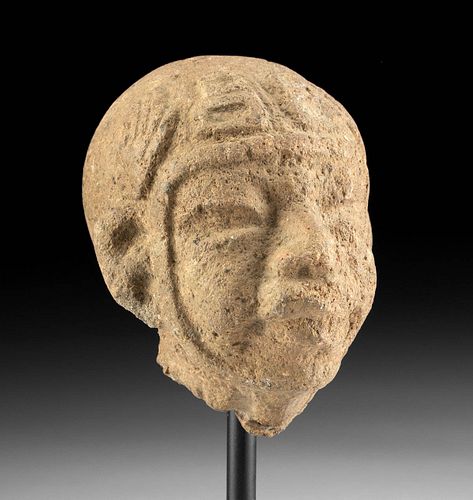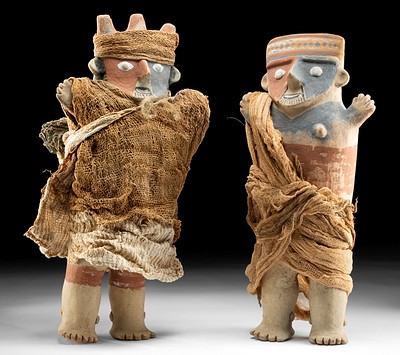Important Olmec Head Fragment, Dwarf or Fetus Figure
Lot 92b
About Seller
Artemis Fine Arts
686 S Taylor Ave, Ste 106
Louisville, CO 80027
United States
Selling antiquities, ancient and ethnographic art online since 1993, Artemis Gallery specializes in Classical Antiquities (Egyptian, Greek, Roman, Near Eastern), Asian, Pre-Columbian, African / Tribal / Oceanographic art. Our extensive inventory includes pottery, stone, metal, wood, glass and textil...Read more
Categories
Estimate:
$8,000 - $12,000
Absentee vs Live bid
Two ways to bid:
- Leave a max absentee bid and the platform will bid on your behalf up to your maximum bid during the live auction.
- Bid live during the auction and your bids will be submitted real-time to the auctioneer.
Bid Increments
| Price | Bid Increment |
|---|---|
| $0 | $25 |
| $300 | $50 |
| $1,000 | $100 |
| $2,000 | $250 |
| $5,000 | $500 |
| $10,000 | $1,000 |
| $20,000 | $2,500 |
| $50,000 | $5,000 |
| $100,000 | $10,000 |
| $200,000 | $20,000 |
About Auction
By Artemis Fine Arts
May 19, 2022
Set Reminder
2022-05-19 10:00:00
2022-05-19 10:00:00
America/New_York
Bidsquare
Bidsquare : Fine Antiquities | Ethnographica | Fine Art
https://www.bidsquare.com/auctions/artemis-gallery/fine-antiquities-ethnographica-fine-art-9350
Featuring a very special collection of Fine Art from the Hollywood Hills, including Picasso & Rookwood ceramics! Also included are many fine examples of classical antiquities, ancient, and ethnographic art from cultures encompassing the globe. Artemis Fine Arts info@artemisfinearts.com
Featuring a very special collection of Fine Art from the Hollywood Hills, including Picasso & Rookwood ceramics! Also included are many fine examples of classical antiquities, ancient, and ethnographic art from cultures encompassing the globe. Artemis Fine Arts info@artemisfinearts.com
- Lot Description
Pre-Columbian, Mexico, Olmec culture, ca. 1200 to 600 BCE. Wow! An incredibly rare, lifelike portrayal of a human head, expertly hand-carved from volcanic stone to present with a cranial deformation - resembling that of an Olmec dwarf or fetus figure. Crowned by a helmet-like headdress reminiscent of ancient ballplayers, the distinctive visage gazes forward displaying incised, lidless eyes that possibly previously held inlays beneath a narrowed brow, a sunken nasal ridge, and full cheeks. The broad nose and fleshy lips project forward above a recessed chin appearing like the snout of an animal. His bulbous cranium extends to the back, while the front of his headdress boasts 4 relief rectangles - possibly representing seeds of maize or another glyph - and vegetal motifs just above each sizable ear. Size: 3.2" L x 2.6" W x 2.8" H (8.1 cm x 6.6 cm x 7.1 cm); 5.9" H (15 cm) on included custom stand.
This stone head is quite noteworthy not only for its distinct characteristics, but also the ambiguity of who or what it was intended to represent. The deformed cranium and snout-like mouth certainly recalls the likeness of Olmec dwarf figures. Dwarfs were believed to have magical powers in the Olmec culture and are often associated with shamanism. This shamanic designation meant dwarfs were highly esteemed members of society, supposedly able to cross over the barrier to the otherworld. Art historian Dr. Carolyn Tate, however, has argued - and confirmed with a group of obstetricians - that some of the characteristics that have been considered dwarf-like are actually more in line with that of a fetus, such as hairlessness, tooth-lessness, the lack of a defined chin, the oversized head, and squinting eyes. Like dwarfs, fetuses were also seen as being able to travel across the barrier to the other world and relay messages from the beyond, as they were new souls just entering our world from the next. The fetus's active metamorphosis from a tadpole or fish-like form to a human one also served as a powerful symbol of the physical and spiritual transformative capacity of the human being. If seen as a fetus, the maize-like glyphs on this example's head could be a reference to the socially constructed parallelism between the rapid growth and transformation of human fetuses and maize. Regardless of the designation, these transitionary figures and this remarkable example are exemplary of Olmec beliefs and values, standing as physical manifestations of the Olmec's most deeply rooted certainty: that to be alive is to be constantly in a state of transformation.
The Olmec are the ancestors of all Mesoamerican civilizations, and their artistic style, practiced in the tropical lowlands of south-central Mexico and diffused outward through extensive trade networks that stretched into northern Mexico and central America, was inspirational for those who came after. The Olmec style became synonymous with elite status in the highlands. They created enormous stone heads, probably the first thing many of us think of when we remember the Olmec, but they also made more easily transportable pieces like this one. Many of these portrayals are of children or infants, but their meaning remains a complete mystery. Based on a few known sculptures and the much later Maya practice of referring to young people as "ch'ok," referring to a maize sprout, there seems to have been a symbolic connection between children and the sprouting of the harvest.
For other examples of Olmec dwarfs and fetuses with similar facial features, please see accession number 1979.206.691 at the Metropolitan Museum of Art, Princeton Museum of Art, object number y1980-7, Figures 20 to 23 on pages 60 to 61 in "Art in Olmec Culture" by Carolyn E. Tate in "The Olmec World: Ritual and Rulership" (Princeton, NJ: The Art Museum, Princeton University, 1995), catalogue numbers 115 to 118 and figure 1 on pages 218 to 221 also in "The Olmec World: Ritual and Rulership," and "Olmec Sculptures of the Human Fetus" by Carolyn Tate and Gordon Bendersky (Perspect Biol Med. 1999 Spring;42(3):303-32).
Provenance: ex-private Saint Petersburg, Florida, USA collection; ex-Barney G. Malone collection, collected in Mexico between 1963 and 1969, and brought into the US prior to 1970
All items legal to buy/sell under U.S. Statute covering cultural patrimony Code 2600, CHAPTER 14, and are guaranteed to be as described or your money back.
A Certificate of Authenticity will accompany all winning bids.
PLEASE NOTE: Due to recent increases of shipments being seized by Australian & German customs (even for items with pre-UNESCO provenance), we will no longer ship most antiquities and ancient Chinese art to Australia & Germany. For categories of items that are acceptable to ship to Australia or Germany, please contact us directly or work with your local customs brokerage firm.
Display stands not described as included/custom in the item description are for photography purposes only and will not be included with the item upon shipping.
#168788Fragment of a larger piece. Loss to bottom of ears. Abrasions and loss of detail to proper left side of face. Expected surface wear with some small nicks in areas, commensurate with age. Otherwise, excellent with impressive preservation of detail and light earthen deposits throughout.Condition
- Shipping Info
-
All shipping is handled in-house for your convenience. Your invoice from Artemis Gallery will include shipping calculation instructions. If in doubt, please inquire BEFORE bidding for estimated shipping costs for individual items.
-
- Buyer's Premium



 EUR
EUR CAD
CAD AUD
AUD GBP
GBP MXN
MXN HKD
HKD CNY
CNY MYR
MYR SEK
SEK SGD
SGD CHF
CHF THB
THB














